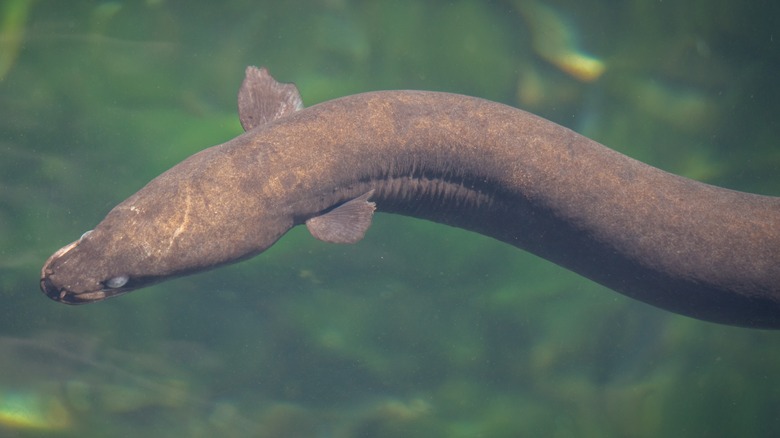The Monstrous 4-Foot-Eel Discovered By A Texas Researcher
Eels are strange creatures that look like snakes. Technically, eels are a type of fish, of which there are more than 800 species, per Ocean Conservancy. American eels are just one type of eel that can be found in the United States. While they live mainly in freshwater, they make their way to saltwater to spawn, and they can live as long as 10 years, according to Britannica. These eels have a range that extends from the Western Atlantic Ocean down to South America, and many call the Mississippi River home.
The average eel is about 2 feet long, but some have been known to grow as long as 5 feet, per the United States Geological Survey. And let's face it — these critters can look pretty darn scary, especially the bigger they are. So imagine the feeling you might get when walking along the beach and coming across a weird snake-looking fish that's about 4 feet long.
The eel was 'as big as they get'
That's what happened to Jace Tunnel, director of the Mission-Aransas Reserve, on January 23, 2023, when he came across a huge eel. He was off the shores of Mustang Island, located between Corpus Christi, Texas and the Gulf of Mexico when he spotted the creature. "This is like basically as big as they get," Tunnel said in the video. The Houston Chronicle reports that the longest American eel ever caught in Texas was about 42 inches long.
But the eel Tunnel found was not the typical size one would expect to see. He states that most eels people will likely see are much smaller. In fact, most are small enough to be used as fishing bait. He explains that many people confused the American eel with the moray eel, but one thing that sets them apart is the location of their dorsal and pectoral fins.
American eels are endangered
As to how the eel might have ended up on the shoreline, Jace Tunnel didn't have an exact reason, but he guessed that it might have something to do with how dams negatively impact their habitat. He says that American eels have almost been "wiped out" because dams in rivers around the area prevent them from being able to make their way out into the ocean and spawn (via Facebook). American eels are in decline, and they are listed as endangered on the International Union for Conservation of Nature's (IUCN) Red List of Threatened Species.
The eel Tunnel found was likely female, and he said that one female can lay up to 4 million eggs. He also explains to viewers that eels aren't picky when it comes to what they like to eat, noting that they will feast on whatever they find in the water, including fish and crabs.

